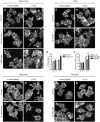Glucose controls morphodynamics of LPS-stimulated macrophages
- PMID: 24796786
- PMCID: PMC4010488
- DOI: 10.1371/journal.pone.0096786
Glucose controls morphodynamics of LPS-stimulated macrophages
Abstract
Macrophages constantly undergo morphological changes when quiescently surveying the tissue milieu for signs of microbial infection or damage, or after activation when they are phagocytosing cellular debris or foreign material. These morphofunctional alterations require active actin cytoskeleton remodeling and metabolic adaptation. Here we analyzed RAW 264.7 and Maf-DKO macrophages as models to study whether there is a specific association between aspects of carbohydrate metabolism and actin-based processes in LPS-stimulated macrophages. We demonstrate that the capacity to undergo LPS-induced cell shape changes and to phagocytose complement-opsonized zymosan (COZ) particles does not depend on oxidative phosphorylation activity but is fueled by glycolysis. Different macrophage activities like spreading, formation of cell protrusions, as well as phagocytosis of COZ, were thereby strongly reliant on the presence of low levels of extracellular glucose. Since global ATP production was not affected by rewiring of glucose catabolism and inhibition of glycolysis by 2-deoxy-D-glucose and glucose deprivation had differential effects, our observations suggest a non-metabolic role for glucose in actin cytoskeletal remodeling in macrophages, e.g. via posttranslational modification of receptors or signaling molecules, or other effects on the machinery that drives actin cytoskeletal changes. Our findings impute a decisive role for the nutrient state of the tissue microenvironment in macrophage morphodynamics.
Conflict of interest statement
Figures






Similar articles
-
Nitric oxide induces ADP-ribosylation of actin in murine macrophages: association with the inhibition of pseudopodia formation, phagocytic activity, and adherence on a laminin substratum.Cell Immunol. 1996 Nov 25;174(1):25-34. doi: 10.1006/cimm.1996.0290. Cell Immunol. 1996. PMID: 8929451
-
NAMPT-mediated salvage synthesis of NAD+ controls morphofunctional changes of macrophages.PLoS One. 2014 May 13;9(5):e97378. doi: 10.1371/journal.pone.0097378. eCollection 2014. PLoS One. 2014. PMID: 24824795 Free PMC article.
-
2-Deoxyglucose selectively inhibits Fc and complement receptor-mediated phagocytosis in mouse peritoneal macrophages II. Dissociation of the inhibitory effects of 2-deoxyglucose on phagocytosis and ATP generation.J Exp Med. 1976 Dec 1;144(6):1484-93. doi: 10.1084/jem.144.6.1484. J Exp Med. 1976. PMID: 1003099 Free PMC article.
-
The cytoskeleton in phagocytosis and macropinocytosis.Curr Biol. 2021 May 24;31(10):R619-R632. doi: 10.1016/j.cub.2021.01.036. Curr Biol. 2021. PMID: 34033794 Review.
-
Modulation of macrophage function for defence of the lung against Pseudomonas aeruginosa.Behring Inst Mitt. 1997 Feb;(98):274-82. Behring Inst Mitt. 1997. PMID: 9382751 Review.
Cited by
-
Myeloid Slc2a1-Deficient Murine Model Revealed Macrophage Activation and Metabolic Phenotype Are Fueled by GLUT1.J Immunol. 2019 Feb 15;202(4):1265-1286. doi: 10.4049/jimmunol.1800002. Epub 2019 Jan 18. J Immunol. 2019. PMID: 30659108 Free PMC article.
-
Contrast-enhanced micro-computed tomography using ExiTron nano6000 for assessment of liver injury.World J Gastroenterol. 2015 Jul 14;21(26):8043-51. doi: 10.3748/wjg.v21.i26.8043. World J Gastroenterol. 2015. PMID: 26185375 Free PMC article.
-
Glycolysis is the primary bioenergetic pathway for cell motility and cytoskeletal remodeling in human prostate and breast cancer cells.Oncotarget. 2015 Jan 1;6(1):130-43. doi: 10.18632/oncotarget.2766. Oncotarget. 2015. PMID: 25426557 Free PMC article.
-
Glucose metabolism is upregulated in the mononuclear cell proteome during sepsis and supports endotoxin-tolerant cell function.Front Immunol. 2022 Nov 18;13:1051514. doi: 10.3389/fimmu.2022.1051514. eCollection 2022. Front Immunol. 2022. PMID: 36466921 Free PMC article.
-
Mitochondrial respiration restricts Listeria monocytogenes infection by slowing down host cell receptor recycling.Cell Rep. 2021 Nov 9;37(6):109989. doi: 10.1016/j.celrep.2021.109989. Cell Rep. 2021. PMID: 34758302 Free PMC article.
References
-
- Mills CD, Kincaid K, Alt JM, Heilman MJ, Hill AM (2000) M-1/M-2 Macrophages and the Th1/Th2 Paradigm. J Immunol 164: 6166–6173. - PubMed
-
- Mantovani A, Sica A, Locati M (2005) Macrophage Polarization Comes of Age. Immunity 23: 344–346. - PubMed
-
- Rodríguez-Prados J-C, Través PG, Cuenca J, Rico D, Aragonés J, et al. (2010) Substrate Fate in Activated Macrophages: A Comparison between Innate, Classic, and Alternative Activation. J Immunol 185: 605–614. - PubMed
Publication types
MeSH terms
Substances
LinkOut - more resources
Full Text Sources
Other Literature Sources

